2. Working the Destination
Between The Lines - Ch: 12 Fighting Fish
As we arrive at the destination the boat slows to the trolling speed that was predetermined during the lure setting exercises in the harbour, then it's riggers down, rods put in their trolling position and lures attached. (Vid 01) This should be done with the boat tracking on a straight course, down sea or quartering the sea for comfort and safety if possible while the gear is set, as the crew will be handling the lures and leaders with sharp hooks attached. The lures are deployed in a set order to minimise lines crossing over and tangling and to stop sharp hook blades coming into contact with lines of other rods. This is accomplished by setting the longest rods first then the next longest and so on until you get to the closest which is usually the short corner. As the lures are deployed each lure goes through a final check of hook points and hook angles in the skirt, leaders, snaps and the line fed through the fingers to check knots, doubles and the line for nicks or abrasion.
Vid 1
As the lures are set the drags are put on the preset drag setting previously decided and marked. The ratchets are then put on. The teasers are then positioned relative to the lure pattern. In most cases the teasers are 10 to 20-feet closer to the boat than the lures they are associated with. If fishing rough conditions the teasers may be set closer to the boat to minimise tangles and if only one is being used it may be set on the opposite side of the boat to the lure run on the short corner.
With experience and some boat set-ups the lures may be deployed in any order if there is little chance of tangling or damaging lines. Once the pattern is set it is checked for lure positions and tweaked if needed, and then a final check that ratchets are on and drags set in the right position. As the crew have practiced these scenarios the lures should be set and tuned quickly. The speed of setting lures is important, especially if you have spotted signs you wish to work while cruising to a destination, as the boat cannot easily be manoeuvred through this period without a high risk of crossing and tangling lines and the longer the setting takes the further you may be from the area you wish to concentrate.
One of the most consistent occurrences in areas that hold fish is current. The first priority is working out which way it is going and its speed either by looking at the wash, noticing how the boat handles or simply using the difference between speed through the water and SOG, (Speed Over Ground) on the electronics. If the SOG is higher than the speed (speed through the water) then you are going with the current. (Fig 01) If the speed is higher than the SOG you are going against the current. (Fig 2)
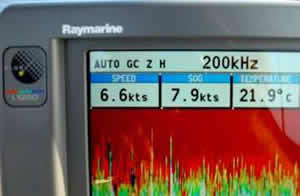 Fig 1 Fig 1 |
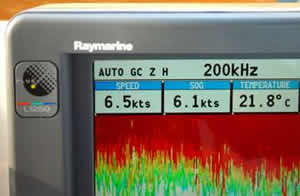 Fig 2 Fig 2 |
As we are trying to imitate a wounded baitfish with a set of lures, the direction of presentation is relevant. As a wounded baitfish is unlikely to swim up current, we plan the trolling route either side on and down current. (Fig 3) The key is to note the angle of the sun especially in the early morning and late afternoon when the angle is low. Most predators find it difficult to attack into the direction of the sun, rather using it to hide their approach. With this in mind, you are best either running with the sun at the side or behind the boat. Once the direction of presentation is established, the next priority is to find the fish. (Fig 4) We have certainly dealt with all the signs, systems, the way the currents work, sounders and what to look for and this is what we now put into practice. The more pieces of the puzzle you can get together in one place the better, and quite some time is spent looking for this El Dorado of fishing spots.
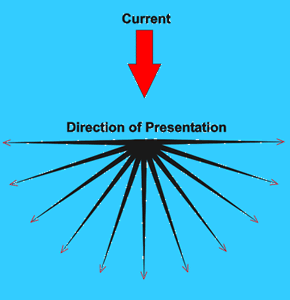 Fig 3 Fig 3 |
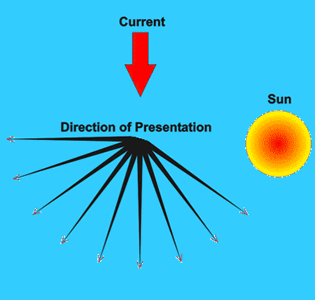 Fig 4 Fig 4 |
Each time you hit a likely spot and do not raise a fish on the first pass, go into ‘attack mode' going around to go over the spot in the direction of presentation previously established. Vary the angle of attack and go over the spot several times. (Fig 5) The longer you stay in the area, the more likely the area is to produce. It is important to remember that there are bite times and you may well be in the right place but at the wrong time. So keep all these spots in mind and mark them on the GPS as you come across them.
|
|
|
If the area is promising, you should gather a number of GPS marks in a rather small area. Once you have done this and decide to go back through them, zoom the GPS to a small area so that you can travel across the marks more accurately. (Fig 6)
As the bite time gets closer, and you come across bait schools, zoom the sounder into as small an area as possible to highlight the bait school and to see if there are any likely predators lurking around the school. (Fig 7) In many situations when the predators are feeding they will separate small balls of bait from the main school as they are then far easier to attack. (Fig 8) Predators are rarely found in the middle of large bait schools. All this translates into the most effective way of catching fish when there are large bait schools. Remain along the edge and work the areas away from the main schools looking for those separated bait balls. (Fig 9) Of course, the depth of the bait schools is relevant when using lures, with the most advantageous being bait schools between 25 fathoms and the surface. By leaving your sounder at a range of around 25 fathoms with the gain as high as possible, you will have a much higher definition that will likely show individual predators.
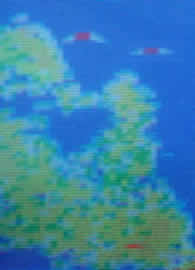 Fig 7 Fig 7 |
 Fig 8 Fig 8 |
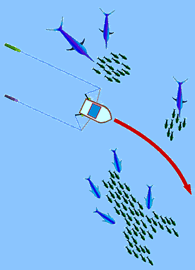 Fig 9 Fig 9 |
Birds are probably one of the best ‘markers'. Their behaviour, body language and antics are all easily read. If they are hovering high and obviously not excited, there is likely to be a bait school deep that is at the time either maintaining its depth or going deeper. If the bird is high and obviously excited, flapping its wings and squawking, the bait school is deep but it is likely it is under attack and heading for the surface. If this is the case, the bird will either hover or circle closer and closer to the surface as the bait comes up. Timing your pass of the area to coincide with the bait hitting the surface is one of the best tactics you can employ. It certainly takes time and observation to learn how to interpret what the birds are doing, but it's important to note the number of birds is not relevant; in fact, a single bird often gives the best signs and results. (Vid 2) Once the fish have been feeding for a while - which can be shown by large numbers of birds having time to gather - the fish are often hard to pull away from the feeding pattern they have locked into. Rather than stay with the large school, once again look for the smaller schools that have broken away.
Vid 2
The way the larger fish feed on the bait is essentially random. They are opportunistic and will attack any way they can to get a feed. However, there is some general characteristic behaviour that should be considered. The fish will spend quite some time working the bait into a nervous ball of flashing light. It is important to let the fish complete this task without spooking or splitting up the fish and bait with a premature run through or past them with the lures.
As the predators begin the attack get into position for the run which should be alongside, not through the school. As the feeding starts, wounded baitfish will drift down current. Invariably part of the feeding tactics of the predators will be to double back to take advantage of the easy pickings. This is the main area and time in which to concentrate your trolling runs.
It would certainly be heaven on earth to find the above scenario consistently. More often than not most of the day is spent searching and hoping as you zigzag down current in likely areas and reposition for the runs by heading straight into the current. Often you'll get a strike from out of nowhere without any of the signs we have discussed being noticed. If the strike results in hook-up, all the better. For the current topic note that you may well have found where the fish are. As with all other forms of fishing, once you have found where one fish is you have likely found quite a few. As soon as you get a strike, mark the position on the GPS and work the area thoroughly, positioning the boat to make the runs in the most appropriate direction of down current with the sun behind you. Here it is very important to understand that lures are a great way of effectively working a small area, not for ploughing on endlessly in a straight line. Once you do get ‘blind' strike try and find the signs associated with it.
It is all really very easy... follow the signs that lead to finding the fish, be there at the right time and stay there and present your lures in a manner that is likely to be most desirable to the fish. It is actually quite hard to make it more complicated than that. The thrilling part is that other factors are involved that make it more of a challenge. There are countless scenarios once you start thinking about factors such as the combinations of sea conditions, the mood of the fish, angle of the sun, direction of the current and speed, height of the sea, direction of the wind sea and swell and where the temperature breaks are and which way they are running. This doesn't even include structure, bait and other signs. It's almost like a three-dimensional chess game where everything interacts and is continually changing. All this is not as complicated as it may seem, as once you realise that many things are interacting, you can work out how to best deal with the situation at hand.






 Fig 5
Fig 5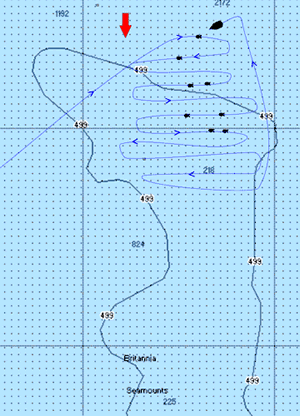 Fig 6
Fig 6